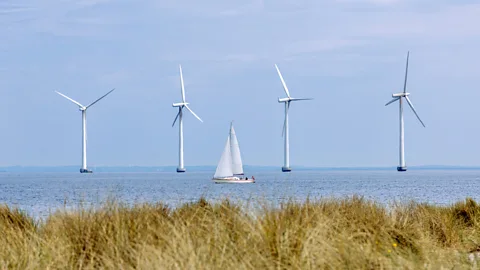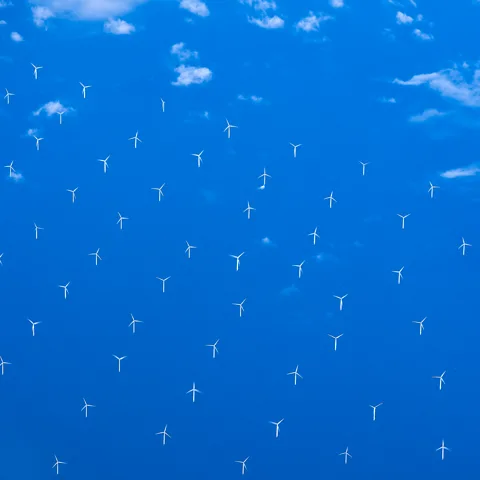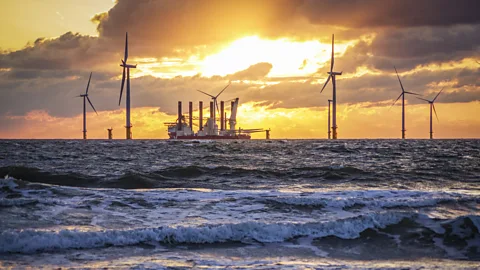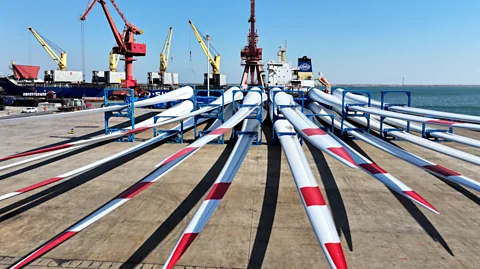From BBC World News
Edited by :- Amal Udawatta
 Getty Images
Getty ImagesAs wind farms expand, some can accidentally "steal" each others' wind – causing worries over some countries' energy transition to net zero.
As offshore wind farms are expanding around the world in the race to meet net zero climate targets, a worrying phenomenon is attracting growing attention: in some conditions, wind farms can "steal" each other's wind.
"Wind farms produce energy, and that energy is extracted from the air. And the extraction of energy from the air comes with a reduction of the wind speed," says Peter Baas, a research scientist at Whiffle, a Dutch company specialising in renewable energy and weather forecasting. The wind is slower behind each turbine within the wind farm than in front of it, and also behind the wind farm as a whole, compared with in front of it, he explains. "This is called the wake effect."
Simply put, as the spinning turbines of a wind farm take energy from the wind, they create a wake and slow the wind beyond the wind farm. This wake can stretch more than 100km (62 miles) for very large, dense offshore wind farms, under certain weather conditions. (Though more typically, the wakes extend for tens of kilometres, according to researchers). If the wind farm is built upwind of another wind farm, it can reduce the downwind producer's energy output by as much as 10% or more, studies suggest.
Colloquially, the phenomenon is known as wind theft – though as Eirik Finserås, a Norwegian lawyer specialising in offshore wind energy, notes: "The term wind theft is a bit misleading because you can't steal something that can't be owned – and nobody owns the wind."
 Getty Images
Getty ImagesStill, he points out that the phenomenon can have a number of negative consequences for wind farm developers, and even, potentially, cause problems across borders (more on this later). There are in fact a number of ongoing disputes between wind farm developers over alleged wind theft, raising concerns in countries that rely on ramping up offshore wind energy to meet their net zero climate targets.
While the problem of wind theft has been long known in principle, it is growing more pressing due to the scale and speed of the offshore expansion, and the size and density of offshore wind farms, experts say.
In the North Sea, which is seeing an offshore wind boom, the impact of such wakes on offshore energy production is likely to increase in the next decades as the sea becomes more crowded with wind farms, according to simulations by Baas together with researchers from the Delft University of Technology and the Royal Netherlands Meteorological Institute. The denser and bigger the wind farm, the stronger the wake effect, Baas says.
A new research project in the UK, launched this spring, aims to provide a clearer picture of the wake effect to help governments and developers improve their planning, and avoid disputes. The project will model wakes and their impact on wind farms' output in 2030, when there will be thousands more turbines in UK waters than today, says project lead Pablo Ouro, a research fellow in civil engineering at the University of Manchester.
"We have seen wake effects for years, and knew they happen," says Ouro. "The problem is that in order to achieve net zero, we need to deploy a given amount of offshore wind capacity. So for 2030, we need to have three times more capacity than we have now, which means that in less than five years, we need to deploy thousands more turbines," he explains.
"[Some of] these turbines are going to be operating very close to those that are already operating, so things are getting more and more crowded. So these wake effects are now starting to have more impact," he says.
 Getty Images
Getty ImagesThe UK government has pledged that by 2030, Britain will generate enough power from renewable sources, such as wind, to cover its electricity needs. A 2025 UK government policy paper highlights the need to better understand wake effects in this context, describing them as an emerging issue that creates uncertainty for offshore wind farmers
Currently, there are a number of disputes in the UK between offshore wind farm developers over potential wake effects, Ouro says. In his view, these disputes are partly caused by uncertainty over the precise impact of wakes. For example, current UK guidelines on how much offshore wind farms should be spaced apart to avoid wake effects, may not reflect the actual extent the wakes can reach, he says. Also, because offshore wind farms are built in clusters, it can be difficult to assess how they might all affect each others' energy output, he explains.
"When you have two wind farms, it's very simple to assess that wind farm A is interacting this much with wind farm B, and vice versa. But what if you have six wind farms, how do they interact with each other? That's what we don't know – but it's going to be happening for sure," as more and more wind farms are built, Ouro says.
"The other issue is that turbines are getting very big," he notes. Turbines have been growing taller and their blades getting larger to capture more energy from the wind. The latest turbines have blades that can span more than 100m (328ft), the length of a football pitch. Among the biggest offshore turbines, a single one can power around 18,000 to 20,000 average European households. But this increase in size could worsen the wake effect since a bigger rotor diameter may create a longer wake, Ouro says, adding that more research should be done to understand the impact.
Grabbing the best spots?
Finserås led a study of wind wakes and regulatory gaps while undertaking doctoral research at the University of Bergen in Norway. The study analyses how the wake of a planned wind farm in Norway could negatively affect a downwind farm in Denmark. Finserås warns that unless the problem of managing wake effects is addressed, it could result in legal and political conflicts and make it harder to invest in wind energy.
"The North Sea and particularly the Baltic Sea, in Europe at least, will likely be a hub for a massive-scale build-out of offshore wind farms," Finserås says. "So this issue of wake effects will very likely permeate the energy transition in the North Sea, and elsewhere."
From an investment perspective, even relatively small wake effects can cause problems for offshore developers, Finserås says. "There are huge costs to building an offshore wind farm," he explains, due to the sheer scale of these farms as well as all the complex related work, including deploying special-purpose vessels. To justify their investment and make a profit, "it's very important for a developer to be able to project that the wind farm will produce a given amount of electricity for 25 or 30 years", the typical lifespan of a wind farm, he says. Even a relatively small, unexpected reduction in that energy output can upset this investment calculation and make the wind farm not financially viable, Finserås says.
If operators or countries try to avoid these wake effects by securing the best spots for themselves, it can create another risk, he warns: wake effects may cause what's known as "the 'race to the water' phenomenon, whereby states rush development in order to reap benefits from the best-yet available wind resources". Rushing development could then increase the risk of ignoring other important aspects of wind farm planning, such as protecting the marine environment, he says.
 Getty Images
Getty ImagesOuro, at the University of Manchester, also sees a growing risk of cross-border problems: "All the disagreements that are filed to date [in the UK] are between UK wind farms, but what if tomorrow there's a dispute between a UK wind farm and a Dutch, Belgian or French wind farm? So, the sooner we anticipate this situation, and lay the groundwork for: 'Ok, that's how we're going to address this,' the better. It reduces uncertainty and is much better for the industry."
Finserås recommends European countries address the problem of wind theft by cooperating and consulting with one another when planning wind farms, as well as introducing clear regulations that help manage wind as a shared resource. Essentially, wind could be treated like other shared marine resources for which there is regulation, such as oil deposits that cross state boundaries, or fish, he suggests. "It's not like [states] haven't regulated similar issues before," he says.
To tackle these thorny issues, it's helpful that the European countries involved generally have good political relations, says Finserås.
"We have to decarbonise energy sectors, and we have to do so very quickly, that's the ambition of the European Union when it comes to offshore wind policies," he says. "So there's no question that all of this is happening very quickly. But we shouldn't be prevented from finding good solutions just because things are happening quickly." After all, he says, it's in nobody's interest to fight over the wind. "There is an incentive to cooperate to find equitable solutions between states, despite the fact that [the wind energy expansion] is going ahead at full speed."
It's not only Europe that's racing to better understand wake effects. China, for example, is rapidly expanding its offshore wind farms, and researchers there have cast a spotlight on the growing impact of wake effects on Chinese offshore wind farms.
Since the project was announced in March, Ouro has been flooded with emails from people interested in it, which in his view shows just how urgent the issue is. "We need to understand this, we need to progress more on the modelling, so everyone is confident, because we need this amount of offshore wind to get to net zero. We have to deliver this."
Comments
Post a Comment